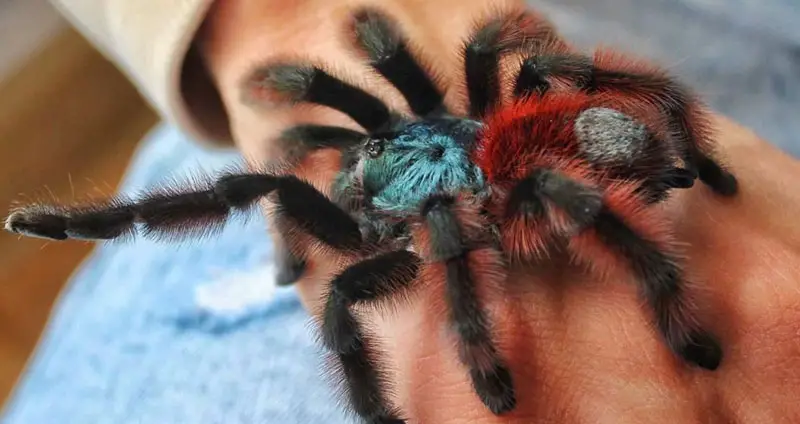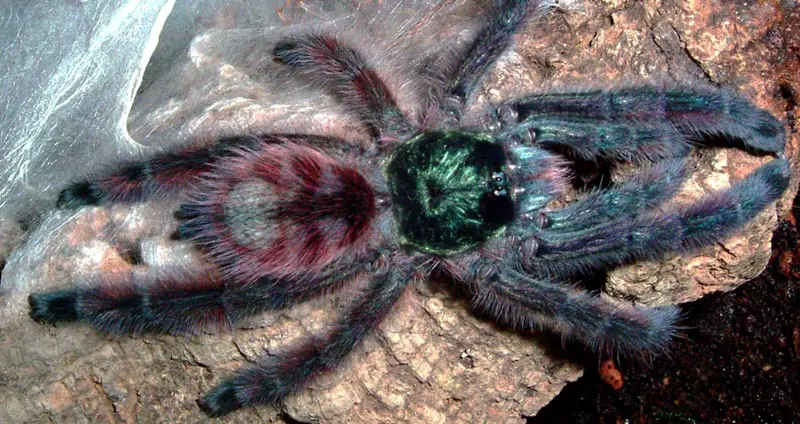Caribena versicolor, or the Martinique Pink Toe tarantula – enjoys a stellar reputation due to its exceptional agility and the unique colors on its fuzzy body. It also happens to be the perfect starter tarantula for hobbyists, both beginner and expert. Of the over 800 tarantula species discovered so far, the Martinique Pink Toe tarantula always seems to be on the bucket list of every tarantula lover for a reason.
Table of Contents
Caribena versicolor Care Sheet
| | |
Common Name |
Martinique Pink Toe |
Species Type |
New world arboreal |
Natural Habitat |
Native to Martinique in the Caribbean Sea. They take residence in tall trees where they spin intricate funnel webs. |
Growth Rate |
Medium growth rate, achieving their maximum legspan in a couple of years. |
Adult Size |
Females reach a legspan of between 5″ and 6″, with males measuring slightly smaller. |
Lifespan |
Females can live up to 12 years, while males often only live to 3 years. |
Enclosure |
The enclosure should be taller than it is wide, with plenty of materials to climb on and attach webbing to. Two inches of substrate should line the floor, and water should always be available. The enclosure should have good airflow. |
Temp/Humidity |
78°F to 82°F with about 65% to 70% humidity. |
Diet |
Good eater that can eat several adult-sized crickets per week. Dubia roaches and mealworms should be used as supplemental food. |
Temperament |
Very docile tarantula. Rarely flicks hairs and almost never bites. Prefers to run away from danger as opposed to fighting it. |
Experience Level |
Beginner – Relatively easy to care for with a good temperament. Maintaining a healthy enclosure can be a bit challenging, though. |
Average Cost |
Slings ~ $45, Males ~ $100, Females ~ $300+ |
Caribena versicolor Appearance
When you purchase one of these tarantulas, you will immediately notice that the spiderlings have fuzzy bright blue to iridescent bodies. Their color tends to change as they mature after undergoing a series of molting, taking on a pink to a red sheen on their carapace and a rich black tree-trunk pattern on their abdomen.
They have long and thick purple hairs that completely cover their legs and abdomen. These hairs are what give the tarantula its thick and ‘fluffy’ appearance.
Spotting the C. versicolor in their cage is simple enough thanks to their unique color. Do keep in mind that they are armed with lots of setae. The Martinique Pink toe tarantula is described as a meaty spider and grows to a moderate size of 6” in leg span. It isn’t uncommon for many of these tarantulas to have weaker knees due to their especially bulky abdomens.
You will observe that adult males are more brightly colored than their female counterparts. Another difference between male and female tarantulas is their size, with the latter growing much longer. The growth rate for younger tarantulas is medium and you should see them grow in a few months. A young female will attain a length of 2.5” within the first year.

via @exotic_venomo / Instagram
Caribena versicolor Temperament
The Caribena versicolor is a new world tarantula, which means that they are timid and less aggressive compared to their old-world counterparts. They would rather avoid any kind of confrontation.
Martinique Pink Toe tarantulas are known for their docile temperaments, which makes them great pets for tarantula enthusiasts who are just getting started. It is not recommended to handle them unless you have the nerve. Before handling the versicolor, you should keep a few things in mind.
Firstly, although the Pink Toe is reasonably slow when calm, if it gets scared or surprised, it will rapidly pick up the pace and quickly jump around. This means if you’re going to handle the Pink Toe tarantula, you will want to make sure you stay calm when it doesn’t! Furthermore, the C. versicolor has urticating hairs, which means it can flick them off at you should it feel threatened. So make sure not to touch the tarantula if you don’t know what you’re doing.
If you do decide to handle them yourself, make sure to at least keep a soft pad underneath that can absorb fall damage should it come to that. These tarantulas are especially bulky and will easily suffer major damage to their abdomens if they come crashing down.
Caribena versicolor lives in warm tropical areas with monsoon periods. They climb up trees, which makes them tree-dwelling tarantulas. They will seek protection from the burning sun in hollow branches, tree crevices, buildings, and leaves.
Housing Caribena versicolor
Buying a cage for the Pink Toe tarantula is a straightforward process because they don’t require complicated enclosures. Being tree-dwelling spiders, their nature is to crawl to taller heights than ground-dwelling spiders, this means that the cage should have a focus on vertical height.
Optimal Caribena versicolor Enclosure
An arboreal enclosure with over a foot of vertical height is recommended for adults, although the spiderlings can make do with smaller enclosures. This height is essential since Caribena versicolor frequently climbs and creates webs high up in their enclosure.
The cage should give the Martinique Pink Toe tarantula lots of room for webbing opportunities and landscaping. The recommended enclosure for this species is the Exo Terra 12″ x 12″ x18″ glass terrarium. This enclosure is well-built, feature-rich, and allows for great cross-ventilation which is important for this species.
Enclosure Decorations
Caribena versicolor is an ideal choice for beginners due to the lack of special enclosure requirements. That being said, you should check out a few supplies that would make the enclosure more habitable. They are arboreal, so they will benefit from a variety of accessories to climb on. Make sure to add at least 2 inches of a moisture-retaining substrate on the ground.
The ideal substrate will help the cage retain humidity and keep the environment fresh. Good mixtures for the substrate will utilize peat moss, coconut fiber, vermiculite, and dirt for firmness. Many owners opt to use a simple coconut fiber substrate.
Since the Pink Toe tarantula likes to take refuge from the sun under tree leaves, you should place an appropriately sized piece of bark or hide in the terrarium. A 10-inch vertical cork bark hide should give the tarantula enough space to completely seal itself.
It is extremely important to keep the versicolor well-hydrated, this can be done by adding a water dish that the tarantula can easily access. This prevents dehydration in addition to keeping humidity levels consistent.
Enclosure Humidity/Heating
Caribena versicolor is known for growing in high humidity environments with regular rainfall. So make sure you can follow the humidity to the tee otherwise your tarantula may die earlier. To keep a high level of humidity, make sure to spray the enclosure regularly using a house-plant spray gun. Be careful not to directly hit the tarantula when doing this because it could surprise them.
The moisture level will evaporate in warmer environments and increase the humidity. Another way to make sure your C. versicolor stays hydrated is to keep a water bowl nearby. This bowl should be cleaned regularly.
The natural habitat of the C. versicolor regularly remains between 80°F and 84°F. Make sure you can regulate the temperature of the enclosure to around this temperature. The temperatures mentioned here are much higher than what is typically recommended for other tarantulas.
If you live in colder climates, you can meet the strict temperature and humidity requirements with the help of a gentle, non light-emitting heat lamp to establish a heat gradient. The tarantula will move to whichever part of the heat gradient it finds comfortable. You can easily monitor the temperature and humidity of the enclosure with the help of a thermometer and hygrometer.
Diet
Caribena versicolor is a tropical arboreal tarantula and is reasonably fast-growing. This means they will eat much more frequently than other tarantulas. It is not easy to overfeed these tarantulas, so don’t be afraid to give them lots of food as often as they will take it. The young ones will eat almost every day while adult tarantulas will eat a few times a week.
In terms of the optimal diet, spiderlings can be given flightless fruit flies and transition into pinhead crickets as they get larger. For adults, use one-inch dubia roaches or four adult crickets weekly.
Health Concerns
Captive tarantulas rarely experience health problems as long as their diet and enclosure are optimal. However, they are susceptible to mites and dehydration. As a result, all C. versicolor tarantula owners should be very observant for slight changes in their pet’s physical condition and behavior to catch any illnesses.
If the tarantula refuses to eat, then it’s likely a sign that it’s molting. Ensure that you properly care for your tarantula when it’s molting due to the fact that it’s quite sensitive.
Caribena versicolor For Sale & Price
These tarantulas are fairly rare to get by and have an expensive price tag as well due to a growing demand by enthusiasts. The asking price for the Caribena versicolor on various different marketplaces is typically in the range of $70 to over $300 depending on the sex and age.
Their docile temperament, high growth rates, and luxurious bodies make them highly valuable among tarantula enthusiasts.

